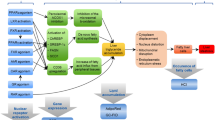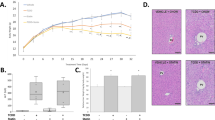Abstract
Liver injury is the leading cause of drug-induced toxicity. For the evaluation of a chemical compound to induce toxicity, in this case steatosis or fatty liver, it is imperative to identify markers reflective of mechanisms and processes induced upon exposure, as these will be the earliest changes reflective of disease. Therefore, an in vivo mouse toxicogenomics study was completed to identify common pathways, nuclear receptor (NR) binding sites, and genes regulated by three known human steatosis-inducing compounds, amiodarone (AMD), valproic acid (VPA), and tetracycline (TET). Over 1, 4, and 11 days of treatment, AMD induced changes in clinical chemistry parameters and histopathology consistent with steatosis. Common processes and NR binding sites involved in lipid, retinol, and drug metabolism were found for AMD and VPA, but not for TET, which showed no response. Interestingly, the pattern of enrichment of these common pathways and NR binding sites over time was unique to each compound. Eleven biomarkers of steatosis were identified as dose responsive and time sensitive to toxicity for AMD and VPA. Finally, this in vivo mouse study was compared to an AMD rat in vivo, an AMD mouse primary hepatocyte, and a VPA human primary hepatocyte study to identify concordance for steatosis. We conclude that concordance is found on the process level independent of species, model or dose*time point.




Similar content being viewed by others
References
Amacher DE (2011) The mechanistic basis for the induction of hepatic steatosis by xenobiotics. Expert Opin Drug Metab Toxicol 7(8):949–965. doi:10.1517/17425255.2011.577740
Anderson N, Borlak J (2008) Molecular mechanisms and therapeutic targets in steatosis and steatohepatitis. Pharmacol Rev 60(3):311–357. doi:10.1124/pr.108.00001
Au JS, Navarro VJ, Rossi S (2011) Review article: drug-induced liver injury: its pathophysiology and evolving diagnostic tools. Aliment Pharmacol Ther 34(1):11–20. doi:10.1111/j.1365-2036.2011.04674.x
Bonet ML, Ribot J, Palou A (2012) Lipid metabolism in mammalian tissues and its control by retinoic acid. Biochim Biophys Acta 1821(1):177–189. doi:10.1016/j.bbalip.2011.06.001
Chen M, Vijay V, Shi Q, Liu Z, Fang H, Tong W (2011) FDA-approved drug labeling for the study of drug-induced liver injury. Drug Discov Today 16(15–16):697–703. doi:10.1016/j.drudis.2011.05.007
da Huang W, Sherman BT, Lempicki RA (2009a) Bioinformatics enrichment tools: paths toward the comprehensive functional analysis of large gene lists. Nucleic Acids Res 37(1):1–13. doi:10.1093/nar/gkn923
da Huang W, Sherman BT, Lempicki RA (2009b) Systematic and integrative analysis of large gene lists using DAVID bioinformatics resources. Nat Protoc 4(1):44–57. doi:10.1038/nprot.2008.211
D’Ambrosio DN, Clugston RD, Blaner WS (2011) Vitamin A metabolism: an update. Nutrients 3(1):63–103. doi:10.3390/nu3010063
Davila JC, Xu JJ, Hoffmaster KA, O’Brien PJ, Storm SC (2008) Current in vitro models to study drug-induced liver injury. Wiley, Chichester
Edgar R, Domrachev M, Lash AE (2002) Gene expression omnibus: NCBI gene expression and hybridization array data repository. Nucleic Acids Res 30(1):207–210
Elferink MG, Olinga P, Draaisma AL et al (2008) Microarray analysis in rat liver slices correctly predicts in vivo hepatotoxicity. Toxicol Appl Pharmacol 229(3):300–309
Gavrilova O, Haluzik M, Matsusue K et al (2003) Liver peroxisome proliferator-activated receptor gamma contributes to hepatic steatosis, triglyceride clearance, and regulation of body fat mass. J Biol Chem 278(36):34268–34276. doi:10.1074/jbc.M300043200
Hakkak R, Al-Dwairi A, Fuchs GJ, Korourian S, Simmen FA (2012) Dietary soy protein induces hepatic lipogenic enzyme gene expression while suppressing hepatosteatosis in obese female Zucker rats bearing DMBA-initiated mammary tumors. Genes Nutr 7(4):549–558. doi:10.1007/s12263-012-0294-6
Hall D, Poussin C, Velagapudi VR et al (2010) Peroxisomal and microsomal lipid pathways associated with resistance to hepatic steatosis and reduced pro-inflammatory state. J Biol Chem 285(40):31011–31023. doi:10.1074/jbc.M110.127159
Hardwick JP (2008) Cytochrome P450 omega hydroxylase (CYP4) function in fatty acid metabolism and metabolic diseases. Biochem Pharmacol 75(12):2263–2275. doi:10.1016/j.bcp.2008.03.004
Houten SM, Denis S, Argmann CA et al (2012) Peroxisomal L-bifunctional enzyme (Ehhadh) is essential for the production of medium-chain dicarboxylic acids. J Lipid Res 53(7):1296–1303. doi:10.1194/jlr.M024463
Jaeschke H, Gores GJ, Cederbaum AI, Hinson JA, Pessayre D, Lemasters JJ (2002) Mechanisms of hepatotoxicity. Toxicological Sciences : An Official Journal of the Society of Toxicology 65(2):166–176
Kienhuis AS, van de Poll MC, Wortelboer H et al (2009) Parallelogram approach using rat-human in vitro and rat in vivo toxicogenomics predicts acetaminophen-induced hepatotoxicity in humans. Toxicological Sciences : An Official Journal of the Society of Toxicology 107(2):544–552
Kienhuis AS, Vitins AP, Pennings JL et al (2013) Cyclosporine A treated in vitro models induce cholestasis response through comparison of phenotype-directed gene expression analysis of in vivo Cyclosporine A-induced cholestasis. Toxicol Lett. doi:10.1016/j.toxlet.2013.06.236
Lee YS, Jeong WI (2012) Retinoic acids and hepatic stellate cells in liver disease. J Gastroenterol Hepatol 27(Suppl 2):75–79. doi:10.1111/j.1440-1746.2011.07007.x
Lee MH, Hong I, Kim M et al (2007) Gene expression profiles of murine fatty liver induced by the administration of valproic acid. Toxicol Appl Pharmacol 220(1):45–59
Lee MH, Kim M, Lee BH et al (2008) Subchronic effects of valproic acid on gene expression profiles for lipid metabolism in mouse liver. Toxicol Appl Pharmacol 226(3):271–284
Leitner JM, Graninger W, Thalhammer F (2010) Hepatotoxicity of antibacterials: pathomechanisms and clinical. Infection 38(1):3–11. doi:10.1007/s15010-009-9179-z
Lin HY, Yu IC, Wang RS et al (2008) Increased hepatic steatosis and insulin resistance in mice lacking hepatic androgen receptor. Hepatology 47(6):1924–1935. doi:10.1002/hep.22252
Lu Y, Boekschoten MV, Wopereis S, Muller M, Kersten S (2011) Comparative transcriptomic and metabolomic analysis of fenofibrate and fish oil treatments in mice. Physiol Genomics 43(23):1307–1318. doi:10.1152/physiolgenomics.0 0100.2011
McCarthy TC, Pollak PT, Hanniman EA, Sinal CJ (2004) Disruption of hepatic lipid homeostasis in mice after amiodarone treatment is associated with peroxisome proliferator-activated receptor-alpha target gene activation. The Journal of pharmacology and experimental therapeutics 311(3):864–873. doi:10.1124/jpet.104.072785
Medina I, Carbonell J, Pulido L et al (2010) Babelomics: an integrative platform for the analysis of transcriptomics, proteomics and genomic data with advanced functional profiling. Nucleic Acids Res 38(Suppl):W210–W213. doi:10.1093/nar/gkq388
Miyazaki M, Flowers MT, Sampath H et al (2007) Hepatic stearoyl-CoA desaturase-1 deficiency protects mice from carbohydrate-induced adiposity and hepatic steatosis. Cell Metab 6(6):484–496. doi:10.1016/j.cmet.2007.10.014
Noriyuki N, Igarashi Y, Ono A, Yamada H, Ohno Y, Urushidani T (2012) Evaluation of DNA microarray results in the Toxicogenomics Project (TGP) consortium in Japan. The Journal of toxicological sciences 37(4):791–801
Ostapowicz G, Fontana RJ, Schiodt FV et al (2002) Results of a prospective study of acute liver failure at 17 tertiary care centers in the United States. Ann Intern Med 137(12):947–954
Rakhshandehroo M, Knoch B, Muller M, Kersten S (2010) Peroxisome proliferator-activated receptor alpha target genes. PPAR research 2010. doi:10.1155/2010/612089
Santangeli P, Di Biase L, Burkhardt JD et al (2012) Examining the safety of amiodarone. Expert Opin Drug Saf 11(2):191–214. doi:10.1517/14740338.2012.660915
Shu Z, Smith S, Wang L, Rice MC, Kmiec EB (1999) Disruption of muREC2/RAD51L1 in mice results in early embryonic lethality which can Be partially rescued in a p53(-/-) background. Mol Cell Biol 19(12):8686–8693
Silva MF, Aires CC, Luis PB et al (2008) Valproic acid metabolism and its effects on mitochondrial fatty acid oxidation: a review. J Inherit Metab Dis 31(2):205–216. doi:10.1007/s10545-008-0841-x
Slob W (2002) Dose-response modeling of continuous endpoints. Toxicol Sci Off J Soc Toxicol 66(2):298–312
Sonoda J, Pei L, Evans RM (2008) Nuclear receptors: decoding metabolic disease. FEBS Lett 582(1):2–9. doi:10.1016/j.febslet.2007.11.016
Sorci-Thomas MG, Thomas MJ (2012) High density lipoprotein biogenesis, cholesterol efflux, and immune cell function. Arterioscler Thromb Vasc Biol 32(11):2561–2565. doi:10.1161/ATVBAHA.112.300135
Thomas CE, Will Y (2012) The impact of assay technology as applied to safety assessment in reducing compound attrition in drug discovery. Expert Opin Drug Discov 7(2):109–122. doi:10.1517/17460441.2012.651122
Uehara T, Ono A, Maruyama T et al (2010) The Japanese toxicogenomics project: application of toxicogenomics. Mol Nutr Food Res 54(2):218–227. doi:10.1002/mnfr.200900169
Ulrich R, Friend SH (2002) Toxicogenomics and drug discovery: will new technologies help us produce better drugs? Nat Rev Drug Discov 1(1):84–88. doi:10.1038/nrd710
van Kesteren PC, Zwart PE, Pennings JL et al (2011) Deregulation of cancer-related pathways in primary hepatocytes derived from DNA repair-deficient Xpa-/-p53± mice upon exposure to benzo[a]pyrene. Toxicol Sci Off J Soc Toxicol 123(1):123–132. doi:10.1093/toxsci/kfr169
Wagner M, Zollner G, Trauner M (2011) Nuclear receptors in liver disease. Hepatology 53(3):1023–1034. doi:10.1002/hep.24148
Yin HQ, Kim M, Kim JH et al (2006) Hepatic gene expression profiling and lipid homeostasis in mice exposed to steatogenic drug, tetracycline. Toxicol Sci Off J Soc Toxicol 94(1):206–216
Zimmerman HJ (1999) Hepatotoxicity: the adverse effects of drugs and other chemicals on the liver, 2nd edn. Lippincott Williams & Wilkins, Philadelphia
Acknowledgments
The authors wish to thank Dr. E.H. Jansen, P.K. Beekhof, and J. Robinson for performing clinical chemistry and histotechnology procedures, and Dr. I. Tonk for help in the dose response analysis. This work was supported by the Netherlands Genomics Initiative/Netherlands Organization for Scientific Research (NWO) no: 050-06-510.
Conflict of interest
The authors do not have any conflict of interest.
Author information
Authors and Affiliations
Corresponding author
Electronic supplementary material
Below is the link to the electronic supplementary material.
Rights and permissions
About this article
Cite this article
Vitins, A.P., Kienhuis, A.S., Speksnijder, E.N. et al. Mechanisms of amiodarone and valproic acid induced liver steatosis in mouse in vivo act as a template for other hepatotoxicity models. Arch Toxicol 88, 1573–1588 (2014). https://doi.org/10.1007/s00204-014-1211-0
Received:
Accepted:
Published:
Issue Date:
DOI: https://doi.org/10.1007/s00204-014-1211-0




